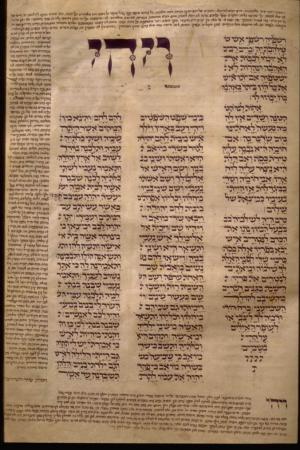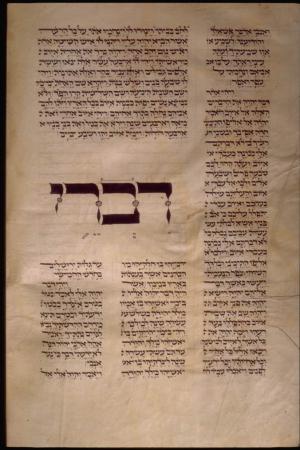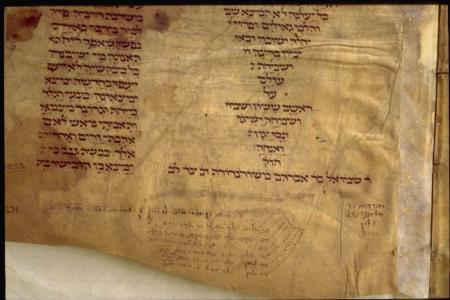Obj. ID: 1523
Hebrew Illuminated Manuscripts Schörndorf Pentateuch, Germany, 14th c.

The manuscript is a liturgical Pentateuch, which originally included the whole Pentateuch, but now contains only most of the book of Deuteronomy. As in other Ashkenazi liturgical Pentateuch it includes also five scrolls, haftarot and Job. Sometimes the liturgical Pentateuch includes other biblical books such as Jeremiah and Isaiah in our manuscript.
It is not known when the manuscript lost its beginning but the lost part is already mentioned in the Latin inscription on fol. 1 (see history).
Two different hands copied the manuscript: the main scribe, Shmuel and the scribe of the commentary, Eliah. Shmuel son of Avraham of Schörndorf (a town northeast of Stuttgart) copied the main text, and wrote his colophon at the end of the manuscript (fol. 112). He also reviewed the text in some pages, adding missing words and correcting wrong ones. The vocalizer of the main text may have been Barukh, as he marked his name in some places (e.g. fols.15v, 25, 25v, 57v, 73, 77). As it is evident from details of codicology, paleography and stylistic elements, the manuscript was produced in Germany during the 14th century (even though according to Bet-Arie, Hebrew Codicology, p. 84, ruling by pencil per folio was not common during this century, rather is suitable to the 13th century). The decorated initial words, with rosettes in spared-ground technique in the junctions of the letters, also points to Germany 14th century, since this motif is very common in Ashkenazi manuscripts of that period (see for example "Shlomo Halevi Vienna Bible", dated 2.8.1344, (Vienna, ONB, Hebr. 4, e.g. fol. 64).
The scribe Eliah copied Rashi’s commentary in semi-cursive script in the margins of the main text. He marked his name once in an acrostic form and once at the end of the text rhymed verses (fols 26 and 41v). It seems that the manuscript was not originally planned to include this commentary, but rather the masorah magna, as is indicated by the ruling and pricking in the upper and lower margins (three in the upper and four in the lower margin). Eliah added Rashi's commentary in the margins as if it was originally planned for the manuscript and in many pages the commentary is written in shaped text framing the main text (e.g. fol. 39). However, in two pages Eliah deleted words written by Shmuel in the main text, in order to make more space for the commentary, rewriting the erased words in a smaller size (see documents of fols. 31, 39). The date of Eliah’s text is not certain, and maybe ascribed to the end of the 14th or the first half of the 15th century.
sub-set tree:
Parchment, I + 112 + I leaves (although it is difficult to distinguish between the flesh and hair sides, it is possible to discern that the manuscript begins with hair side).
Measurements
|
Full page: (420-433) X (299-306) mm. (e.g. fols. 1, 4, 6v, 44, 100) |
|
space: (298-308) X (201-206) mm. (e.g. fols. 2, 21v, 25, 31, 36v, 51, 82, 94v, 98, 98v, 107, 111v) |
|
Width of the main text with commentary: (232-259) mm. (e.g. fols. 3, 4, 5, 8v, 17v, 39) |
|
Column width: (55-57) mm. |
|
Intercolumnar space: (17-19) mm. |
Scribes
|
Scribe A: Shmuel bar Avraham of Schörndorf |
The main text |
Fols. 1-112v |
|
Scribe B: Eliah |
Rashi’s commentary |
Fols. 1-41v |
Script
|
The main text is written in square Ashkenazi script in dark brown ink. Initial words for haftaroth (fols. 41v-80) and for Isaiah (fol. 111v) are written in display letters. |
|
Rashi’s commentary is written in semi-cursive Ashkenazi script in light brown ink |
Columns:
The main text is written in three columns, except for end of books and sections which occupy two text columns space (e.g. fols. 26, 31, 33, 39, 41v, 80, 92v, 112); Song of Deborah (fols. 49-49v) and Song of David (fols. 71v-72), writen in brickwork pattern.
Number of lines
|
Main text: |
Mainly 35 lines per column in each page. |
|
Rashi’s commentary: |
Written in various number of lines, mainly in the outer margins, and often beginning in the upper margins (e.g.: fols. 24, 25, 1-33, 35-41), and continuing on the lower margins (e.g. fols. 13, 19, 22, 23v). |
Ruling
Ruling by plummet, 3 + 36 + 4 horizontal lines (e.g. on fols. 43-48v, 77-78, 82, 89, 97-98v, 103) and 1 + 3 + 3 + 3 lines on the recto (e.g. on fols. 43, 45, 88, 98), and 3 + 3 + 3 + 1 vertical lines on the verso (e.g. on fols. 68v, 72v, 99v).
Pricking
Pricking by quires is discernible in the inner margins (e.g. on fols. 71, 84v, 95, 107, 110v), in some pages also in the lower margins (e.g. fols 3-7, 2-24, 29-32) and in the upper margins where one prick only is discernible (e.g. fols 17-32, 40, 49-56, 57-63).
Quires
14 quires of 8 leaves each.
Catchwords
Decorated catchwords for each quire, written horizontally, in the lower left-hand corner of last verso of each quire. Some are decorated with a series of small “v”s with a line in the middle, forming a triangle above the word (fols. 8v, 16v, 56v, 72v, 80v, 104v); others are decorated with thin scrolls (fols. 24v, 32v, 40v, 48v, 64v, 88v); fol. 96v is decorated with a head of lion).
Hebrew numeration
None
Blank leaves
None
The decoration of initial words of all books was made by the main scribe, as he was writing the text.
No colour is used besides light and dark brown ink. Some initial words are decorated with rosettes within the letters, executed in spared-ground technique.
- 8 decorated initial words: at the beginning of 8 books and sections: Esther (fol. 26v), Song of Songs (fol. 31), Ruth (fol. 33), Ecclesiastes (fol. 35), Lamentations (fol. 39), Haftaroth (fol. 41v), Job (fol. 80) and Jeremiah (fol. 92v).
- 13 Decorated Catchwords for all quires: decorated with a motif of “V” with a small vertical line inside (fols. 8v, 16v, 56v, 72v, 80v, 104v), with dotted scrolls extending from the letters (fols, 24v, 32v, 40v, 48v, 64v, 88v); one of them is decorated with an animal head (fol. 96v).
- Shaped texts: at the end of most books and sections (fols. 26, 31, 33, 39, 41v, 80, 112), as well as the end of the commentary (fols. 31, 39,).
- Decorated letters: leaf motifs or dotted scrolls decorate some letters within the text, to emphasize some words and names (see scribal note): Baruch ברוך (e.g. fols. 15v, 25, 25v, 57v, 57v, 73, 77), Shmuel שמואל (e.g. fols. 60, 69).





















